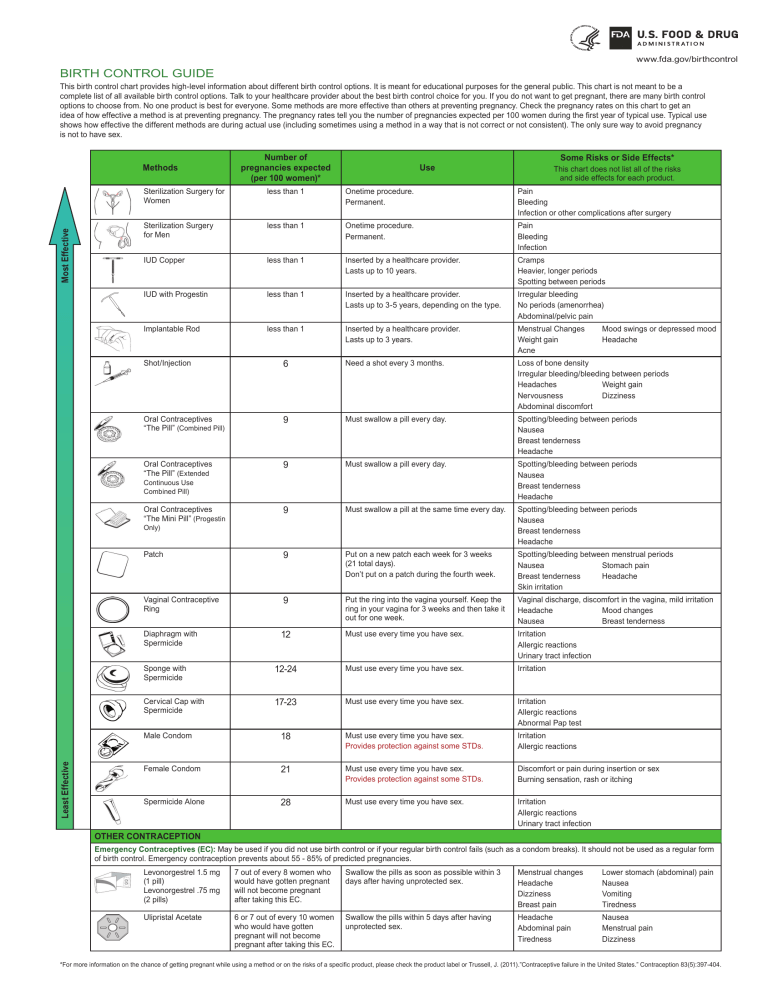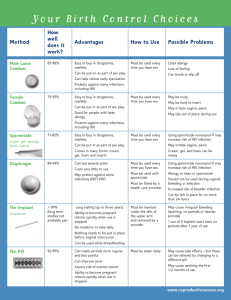
www.fda.gov/birthcontrol
BIRTH CONTROL GUIDE
This birth control chart provides high-level information about different birth control options. It is meant for educational purposes for the general public. This chart is not meant to be a
complete list of all available birth control options. Talk to your healthcare provider about the best birth control choice for you. If you do not want to get pregnant, there are many birth control
options to choose from. No one product is best for everyone. Some methods are more effective than others at preventing pregnancy. Check the pregnancy rates on this chart to get an
idea of how effective a method is at preventing pregnancy. The pregnancy rates tell you the number of pregnancies expected per 100 women during the first year of typical use. Typical use
shows how effective the different methods are during actual use (including sometimes using a method in a way that is not correct or not consistent). The only sure way to avoid pregnancy
is not to have sex.
Most Effective
Methods
Number of
pregnancies expected
(per 100 women)*
This chart does not list all of the risks
and side effects for each product.
Sterilization Surgery for
Women
less than 1
Onetime procedure.
Permanent.
Pain
Bleeding
Infection or other complications after surgery
Sterilization Surgery
for Men
less than 1
Onetime procedure.
Permanent.
Pain
Bleeding
Infection
IUD Copper
less than 1
Inserted by a healthcare provider.
Lasts up to 10 years.
Cramps
Heavier, longer periods
Spotting between periods
IUD with Progestin
less than 1
Inserted by a healthcare provider.
Lasts up to 3-5 years, depending on the type.
Irregular bleeding
No periods (amenorrhea)
Abdominal/pelvic pain
Implantable Rod
less than 1
Inserted by a healthcare provider.
Lasts up to 3 years.
Menstrual Changes
Weight gain
Acne
Mood swings or depressed mood
Headache
Shot/Injection
6
Need a shot every 3 months.
Loss of bone density
Irregular bleeding/bleeding between periods
Headaches
Weight gain
Nervousness
Dizziness
Abdominal discomfort
Oral Contraceptives
“The Pill” (Combined Pill)
9
Must swallow a pill every day.
Spotting/bleeding between periods
Nausea
Breast tenderness
Headache
Oral Contraceptives
“The Pill” (Extended
9
Must swallow a pill every day.
Spotting/bleeding between periods
Nausea
Breast tenderness
Headache
Oral Contraceptives
“The Mini Pill” (Progestin
9
Must swallow a pill at the same time every day.
Spotting/bleeding between periods
Nausea
Breast tenderness
Headache
Patch
9
Put on a new patch each week for 3 weeks
(21 total days).
Don’t put on a patch during the fourth week.
Spotting/bleeding between menstrual periods
Nausea
Stomach pain
Breast tenderness
Headache
Skin irritation
Vaginal Contraceptive
Ring
9
Put the ring into the vagina yourself. Keep the
ring in your vagina for 3 weeks and then take it
out for one week.
Vaginal discharge, discomfort in the vagina, mild irritation
Headache
Mood changes
Nausea
Breast tenderness
Diaphragm with
Spermicide
12
Must use every time you have sex.
Irritation
Allergic reactions
Urinary tract infection
Sponge with
Spermicide
12-24
Must use every time you have sex.
Irritation
Cervical Cap with
Spermicide
17-23
Must use every time you have sex.
Irritation
Allergic reactions
Abnormal Pap test
Continuous Use
Combined Pill)
Only)
Least Effective
Some Risks or Side Effects*
Use
Male Condom
18
Must use every time you have sex.
Provides protection against some STDs.
Irritation
Allergic reactions
Female Condom
21
Must use every time you have sex.
Provides protection against some STDs.
Discomfort or pain during insertion or sex
Burning sensation, rash or itching
Spermicide Alone
28
Must use every time you have sex.
Irritation
Allergic reactions
Urinary tract infection
OTHER CONTRACEPTION
Emergency Contraceptives (EC): May be used if you did not use birth control or if your regular birth control fails (such as a condom breaks). It should not be used as a regular form
of birth control. Emergency contraception prevents about 55 - 85% of predicted pregnancies.
Levonorgestrel 1.5 mg
(1 pill)
Levonorgestrel .75 mg
(2 pills)
7 out of every 8 women who
would have gotten pregnant
will not become pregnant
after taking this EC.
Swallow the pills as soon as possible within 3
days after having unprotected sex.
Menstrual changes
Headache
Dizziness
Breast pain
Lower stomach (abdominal) pain
Nausea
Vomiting
Tiredness
Ulipristal Acetate
6 or 7 out of every 10 women
who would have gotten
pregnant will not become
pregnant after taking this EC.
Swallow the pills within 5 days after having
unprotected sex.
Headache
Abdominal pain
Tiredness
Nausea
Menstrual pain
Dizziness
*For more information on the chance of getting pregnant while using a method or on the risks of a specific product, please check the product label or Trussell, J. (2011).”Contraceptive failure in the United States.” Contraception 83(5):397-404.




